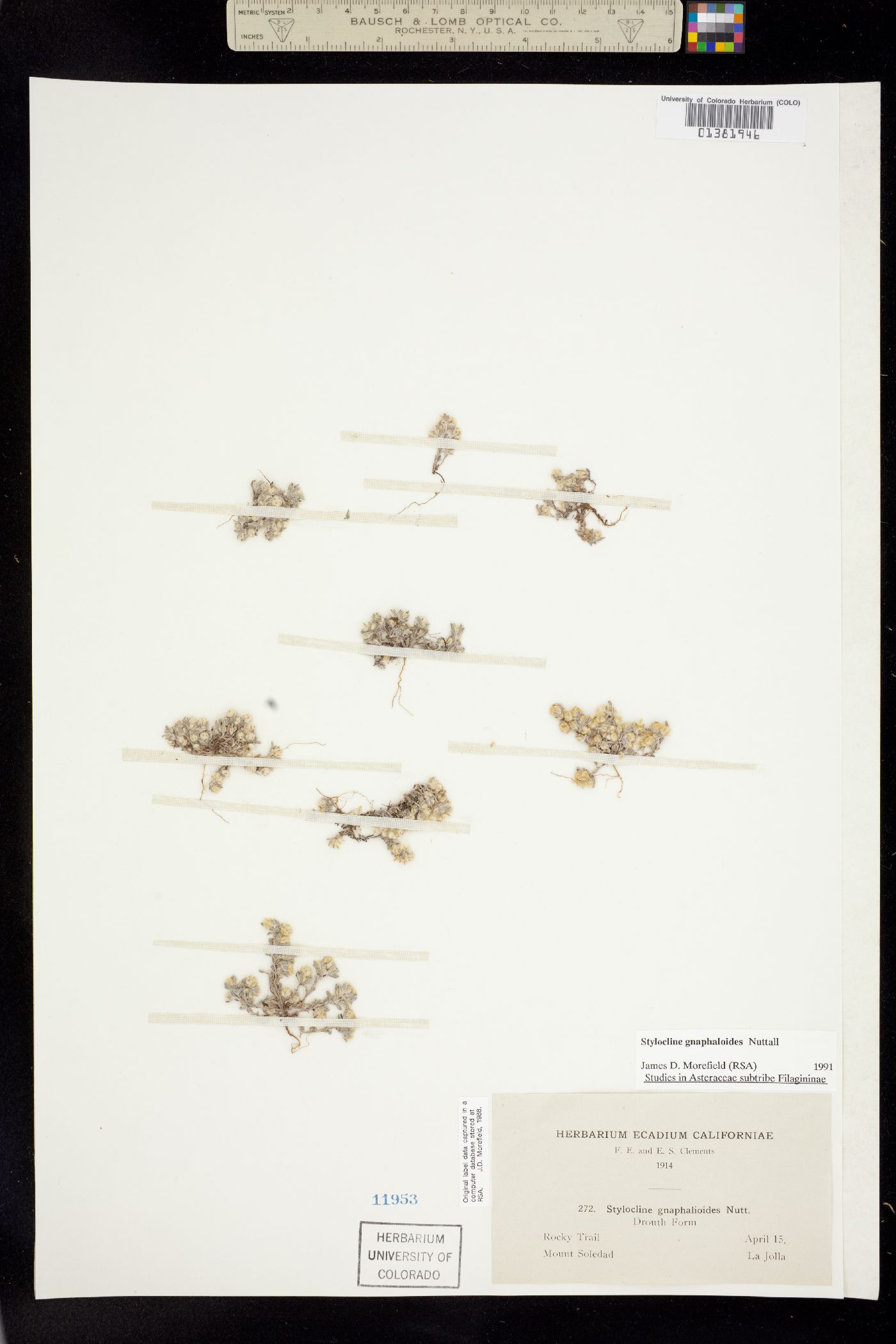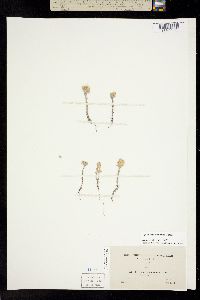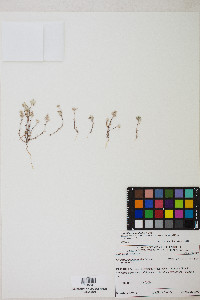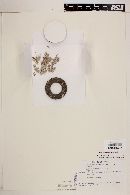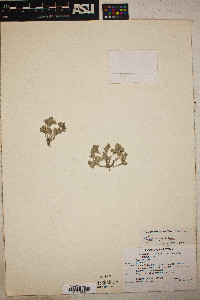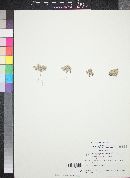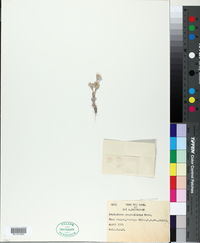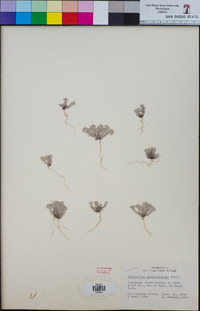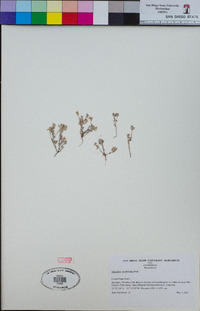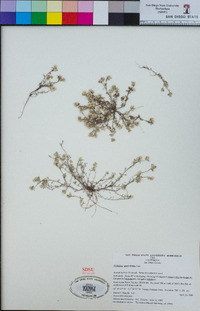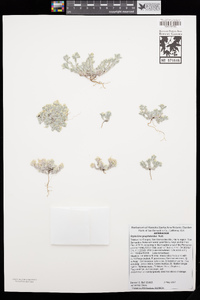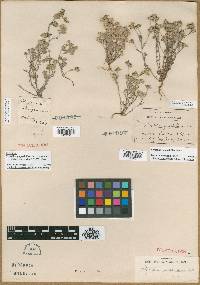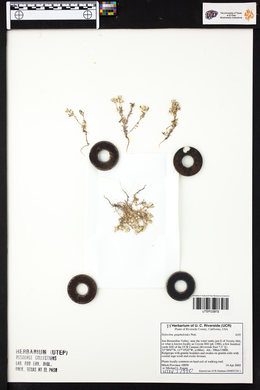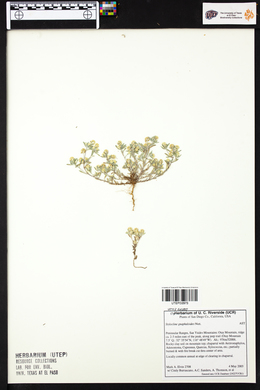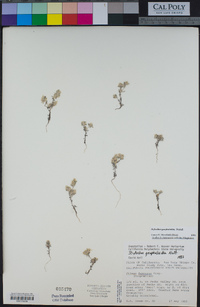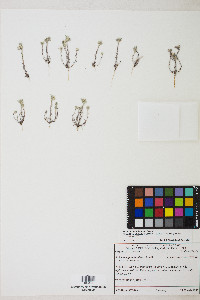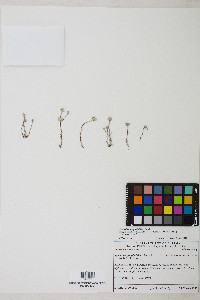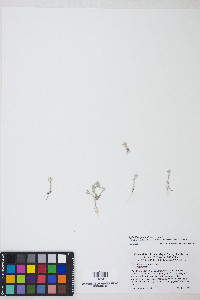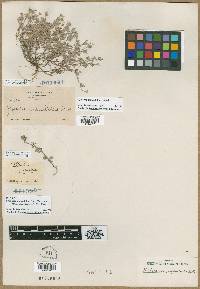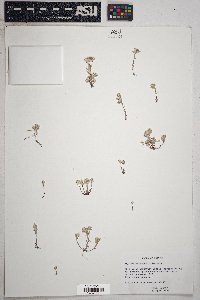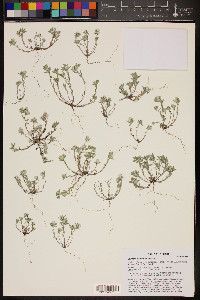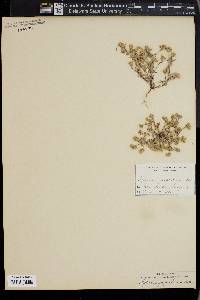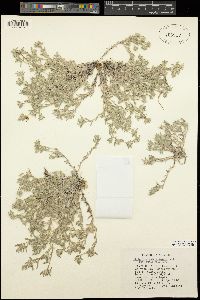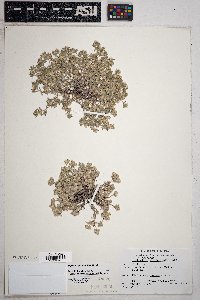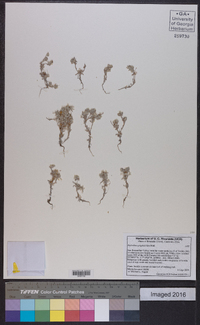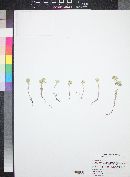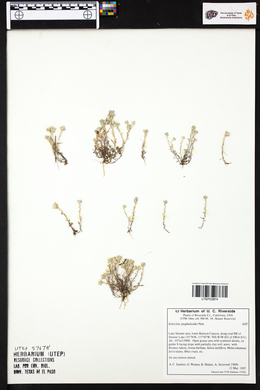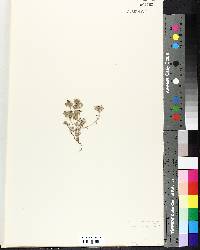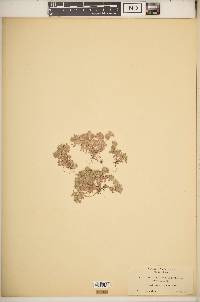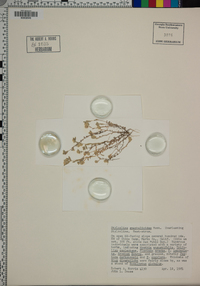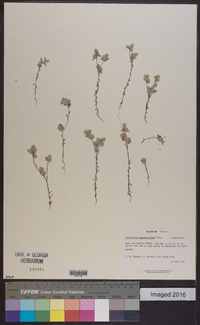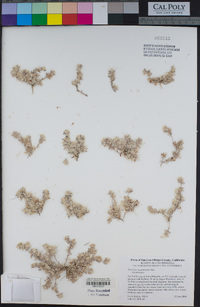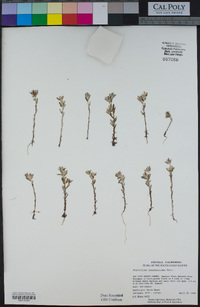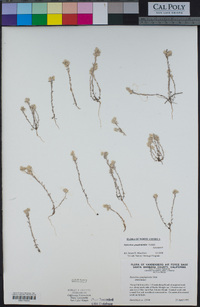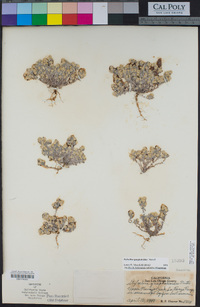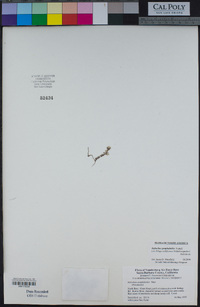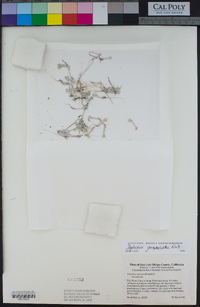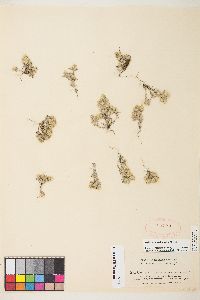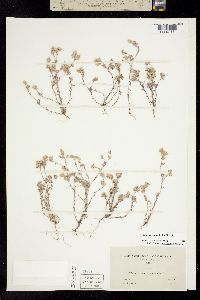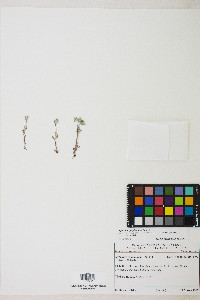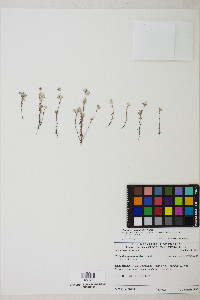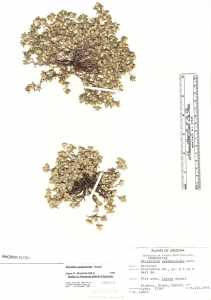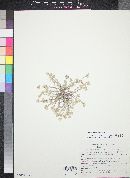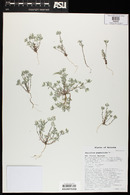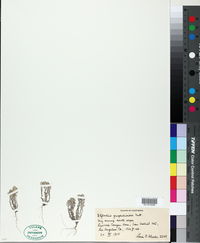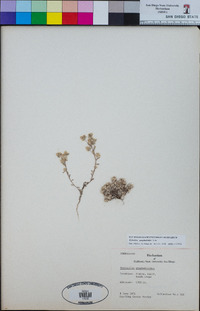Stylocline gnaphaloides
|
|
|
|
Family: Asteraceae
everlasting nest straw, more...Mountain Neststraw, desert nest straw
[Stylocline gnaphalioides Nutt.] |
Plants 1-15(-20) cm. Leaves mostly blunt, not or scarcely mucronate, longest 6-14 mm; largest capitular leaves spatulate to ± elliptic or oblong, 4-13 × 1.5-3 mm. Heads in dichasiform or proximally ± racemiform arrays, ± spheric, largest 3-6 mm, arachnoid to thinly lanuginose (often shiny, appearing nearly glabrous, indument obscured by palea wings). Phyllaries ± persistent, ± ovate, 1-3.5 mm, subequal. Receptacles narrowly cylindric, 1.3-2.2 mm, heights 5-8 times diams.; scars ± evenly distributed, slightly sunken. Pistillate paleae: longest 1.8-4.5 mm, winged proximally and distally; wings broadly ovate (bases rounded or cordate), widest in proximal 1/3 of palea lengths; bodies (except midnerves) chartaceous; outermost paleae ± saccate. Functionally staminate florets 2-5; ovaries vestigial, 0-0.2 mm; corollas 1-1.8 mm. Cypselae 0.8-1 mm, compressed; pappi: staminate of 1-5(-6) smooth to barbellulate bristles 1.3-1.9 mm. 2n = 28. Flowering and fruiting (Jan-)Mar-May(-Jul). Dry, open, sandy slopes, flats, dry drainages (relatively mesic sites in deserts), often on old disturbances; 0-1200(-1700) m; Ariz., Calif.; Mexico (Baja California, Sonora). Stylocline gnaphaloides (often misspelled 'gnaphalioides') is relatively common in southwestern California, extending to the nearer Channel Islands, the San Francisco Bay area, and most of Baja California; it is not known from the Colorado River valley; it occurs in (mainly) disturbed areas of south-central Arizona and adjacent Sonora, Mexico. A specimen from Zion National Park, Utah, in 1937 is likely either mislabeled or from an introduction that did not persist. Forms with larger, often hairier heads (Stylocline gnaphaloides var. bigelovii A. Gray, S. arizonica Coville) are more frequent inland but also occur (with intermediates) on the California Channel Islands and elsewhere; no taxonomic segregation seems warranted. Sterile hybrids with Logfia filaginoides do not much resemble S. citroleum, which is suspected to have originated from such parentage (J. D. Morefield 1992, 1992b). Sterile hybrids between S. gnaphaloides and L. arizonica superficially resemble S. psilocarphoides.
FNA 2006, Jepson 2012, Kearney and Peebles 1969 Duration: Annual Nativity: Native Lifeform: Forb/Herb General: Herbaceous annuals, to 20 cm tall, stems 1 or more, erect, or ascending to prostrate, branches forked, generally evenly leafy but becoming more or less leafless between distal forks, sometimes older branches woody, herbage gray and cobwebby to tomentose. Leaves: Alternate, sessile, linear to elliptic or spoon-shaped (spatulate) to obovate, 6-14 mm long and 1.5-3 mm wide or less, margins entire, blades becoming slightly reduced in length but wider, densely crowded and bract-like distally, apices generally obtuse, sometimes with a tiny awn (mucronate). Flowers: Green or white with long, white, cobwebby hairs, disciform; outer flowers pistillate, 12-25 or more with filiform corollas, each subtended by a boat-shaped, papery paleae 1-4.5 mm long, with broadly ovate wings, bracts enclosing the pistillate florets with a narrow, only moderately wooly body, this with broad, thinly membraneous (hyaline) wings throughout its length, disc florets staminate or hermaphrodite and infertile, clustered in small groupings of 2-5, corollas 1-2 mm long, generally 5-lobed, obscure and narrowly cylindric, involucres spheric, largest 3-6 mm in diameter, surfaces cobwebby with arachnoid to thinly lanuginose white hairs, or sometimes shiny and appearing nearly glabrous with hairs obscured by palea wings, phyllaries ovate, 1-3.5 mm long, subequal, persistent, receptacles narrowly cylindric, 1-2 mm long, with evenly distributed, slightly sunken scars, ovaries vestigial, 0-0.2 mm long, anther bases tailed, with triangular tips, style tips linear-oblong, heads borne in glomerule-like clusters at branch tips. Fruits: Cypselae (achenes) obovoid and laterally compressed, to 1 mm long, pistillate florets with each achene enclosed by the palea and deciduous with them, hermaphrodite florets with more or less flattened paleae. Staminate or hermaphrodite pappi of 1-6 smooth Ecology: Found in sandy soils, on slopes, flats, disturbed areas, dry drainages or relatively mesic sites in deserts, from 0-5,500 ft (0-1676 m); flowering January-July. Distribution: Arizona, California; Mexico. Notes: This small annual has greenish-white cottony heads borne in small clusters at branch tips with leafy subtending bracts, similar to Logfia. Good indicators for this species are the broad, hyaline wings of the moderately woolly bracts enclosing the pistillate florets; if the bracts are densely long-woolly with the hyaling appendage only at the bract tips, check S. micropoides. FNA notes that; Stylocline gnaphaloides...is not known from the Colorado River valley; it mainly occurs in disturbed areas of south-central Arizona and adjacent Sonora, Mexico. Kearney and Peebles note this species occurring in Maricopa, Pinal, cochise, and Pima counties in Arizona. Ethnobotany: Unknown. Synonyms: None Editor: LCrumbacher2012 Etymology: Stylocline comes from the Greek stulos for "column" and kline, "a bed," from the long receptacle, while gnaphaloides means like genus Gnaphalium. |

